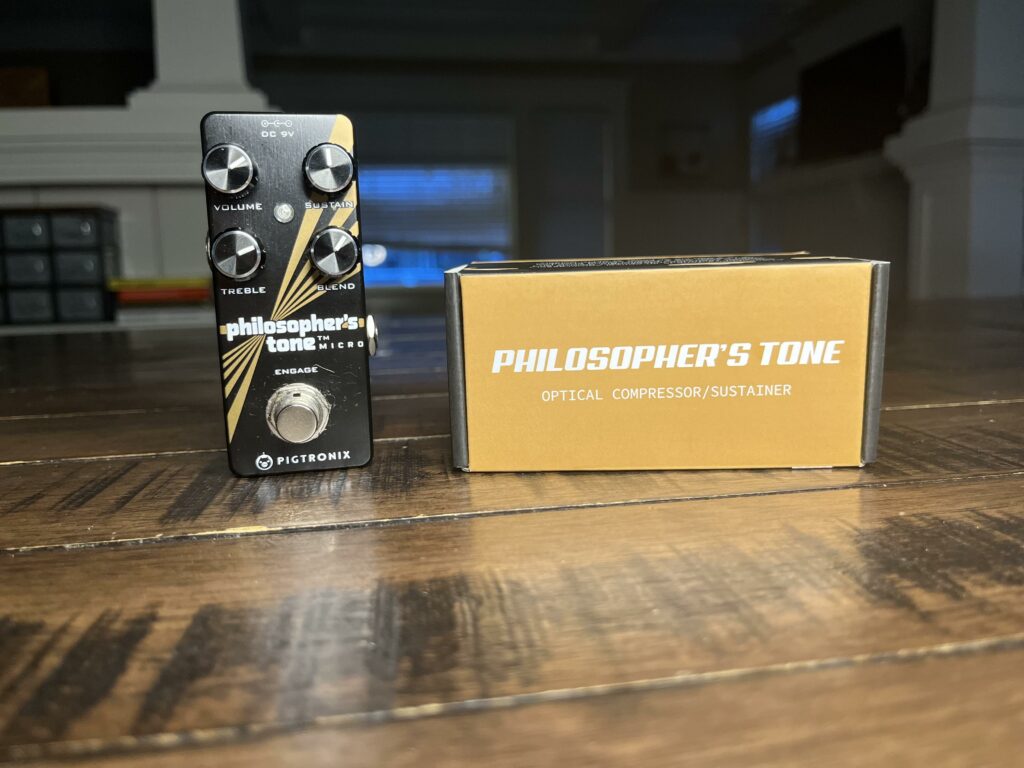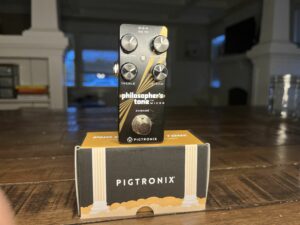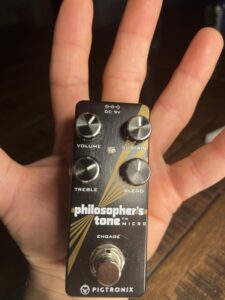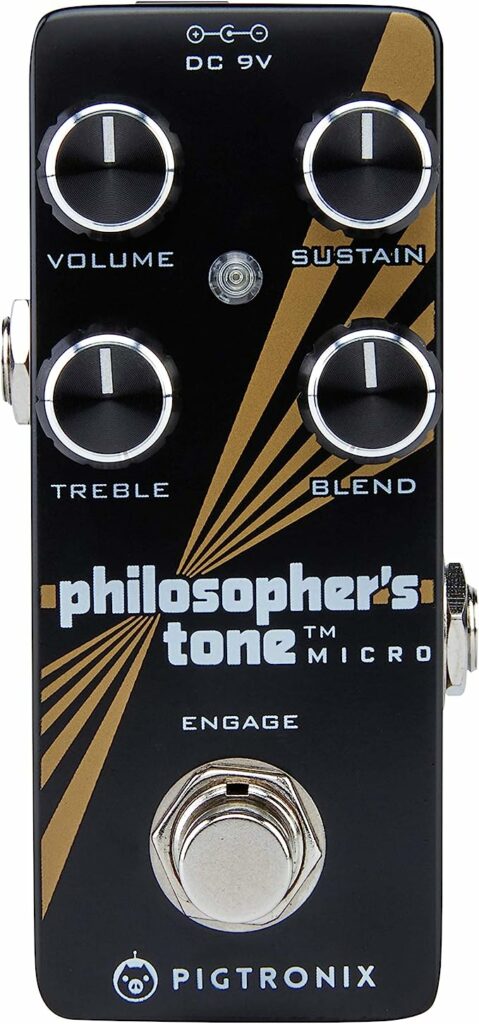The Philosopher's Tone by Pigtronix is a fantastic transparent compressor/sustainer that offers enough flexibility and tone options to make it a worthy addition to your pedalboard.
In true Pigtronix fashion, the Philosopher's Tone takes up minimal space on your board, is high-quality, and is easy to work with. The additional Treble knob is a fantastic EQ that can help shape your tone to be more sparkly without giving you ear fatigue or more midrange and punchy.
If you want to add a compressor pedal to your rig, I highly recommend the Pigtronix Philosopher's Tone to fill that spot.
If you’re wondering if the Pigtronix Philosopher’s Tone micro pedal is worth a spot on your pedal board, then you are in the right place.
Compression pedals are an often misunderstood signal processor that can either pump up your playing or kill your dynamics and mess up your tone.
For this reason, this Pigtronix Philosophers Tone review will dive more into the sounds it can help you produce, so you can hear why you need a compressor pedal in your signal chain.
If you don’t already own a compressor pedal, The Philosopher’s Tone micro pedal is a worthy compressor/sustain pedal. It’s easy to control your dynamics and help each note of your instrument heard, even in a busy mix.
Before we jump into the nitty gritty of what this tiny but mighty pedal can do, let’s understand why it being an “optical compressor” is important.

Table of Contents
The power of optical compressors for controlling dynamics
I’ve always been a massive fan of optical compressors, especially on vocals and guitars. While optical compressors are transparent, they have a fantastic way of pushing a sound forward, emphasizing the midrange, and responding well to dynamic performances.
Some of the most popular optical compressors are from the company Universal Audio. These include the LA2A (an optical tube compressor) and the LA3A (a solid-state optical compressor).
The LA3A is a favorite on electric guitars because it will respond faster due to the solid-state circuitry than the LA2A. This helps ensure that the gain reduction does not wash out more aggressive and arpeggiated playing.
While the Pigtronix Philosopher’s tone isn’t modeled after the LA3A, you will get similar characteristics (with some extra goodies), to this studio classic, with a tiny pedalboard footprint.
So the question you’re probably asking yourself is…
How does the Pigtronix Philosopher’s Tone micro pedal work?

I’ve already hinted at it; the Pigtronix Philosopher’s Tone sounds fantastic. It is a no-frills, all-analog box that ensures you spend more time playing than tweaking.
While there are only four knobs on the guitar pedal, each one plays a crucial part in shaping your compression and gives you plenty to work with.
Exploring the Sustain Knob
The sustain controls the amount of compression on your guitar signal. As you crank the sustain clockwise, you will begin to feel the compressor in your playing. You’ll lose the natural pick attack and amplify the noise of your amplifier.
When I was playing with the Philosopher’s Tone, I would say that cranking the sustain knob adds “too much salt” to your tone.
However, when you put the sustain knob between 10 and 3 o’clock, you can get some wonderfully transparent compression and added sustain that evens your guitar playing and makes it sound more “radio ready.”
Exploring the Volume Knob
The volume knob helps you adjust your compressed output signal to be level matched.
The challenge many inexperienced players have with compression is not level-matching the before and after signals and thinking the compressor sounds better because it’s louder. And often, this is a surefire way to over-compress a sound and ruin your tone.
You have to be careful with this volume knob because it will give you this same illusion. So it’s critical to ensure that you don’t have lots of volume loss, which can negatively affect the response of your other pedals when you turn it off.
A huge benefit of the volume knob is that you could use it as a clean boost (turn the sustain full counter-clockwise) and drive the amplifier tubes for some tasty breakup and solo sections.
Exploring the Treble Knob
The Treble Knob on the Pigtronix Philosopher’s Tone is another “secret sauce” addition that is an EQ boost/cut to give you a variety of dark and bright tones.
To my ear, when the knob is at 12 o’clock, it has a flat frequency response. However, as you turn the dial clockwise, you begin to boost the 2k range, adding a chimey glow to your notes.
As you dial it counter-clockwise, you remove some of this 2k range, giving you a darker, moodier-sounding guitar tone.
From my experiments, you can push this as hard as you want without it getting shrill and fatiguing on the ears, which makes this a very musical EQ.
This little knob can help you cut through a busy mix or keep your tone earthy and round in a more sparse arrangement.
Exploring the Blend Knob
I don’t think a compressor should ever come without a parallel blend knob. There’s something about “tucking in” your compressed sound effect underneath your original instrument’s original tone to help your playing remain musical and dynamic.
The blend knob does what is advertised. It helps you push your compressor settings harder while dialing it back with the blend knob to prevent the compression from throwing off your playing and sounding unnatural to a listener.
I found that using the blend knob helps thicken the tone of your guitar and keep your notes upfront and articulate while maintaining touch sensitivity from my playing.
How does it hold up to more extreme sustain settings?
While I wouldn’t consider using the Philosopher’s Tone for extreme compression settings, you can get away with it using the blend knob.
However, as with other compressor pedals, the more you use, the more you amplify your amp’s noise. Also, it will begin to feel unnatural as you’re playing, and you will lose any sense of dynamics within your playing.
So you can use the blend knob on the Philosopher’s Tone to help wrangle in the madness. However, I’ve found the sweet spot in the moderate range with a bit of the blend knob dialed back.
- It is simple in function yet flexible in the tones it can give you
- Added clean boost and EQ circuit is very useable
- The pedal is exceptionally well-built
- I love the small footprint - it doesn't take up precious space on your board
- No control over the attack, release, or ratio
- It doesn't come with a power supply (also doesn't take batteries)
Original audio examples:
Here are some audio examples to give you an idea of some great practical tones you can get out of the Pigtronix Philosopher’s Tone micro pedal.
It’s important to state that demoing the sound of a compressor pedal can be challenging. Functional compression is subtle. When trying to hear what it’s doing to the tone, notice how a compressor helps the sound “sit in the mix” more than the uncompressed version.
Each sound sample below was recorded with a Fender Vintera ’60s Jaguar HH Modified into a Supro Delta King 12” guitar amp. To record, I used a 47 FET replica into a Universal Audio Apollo Twin X. No processing was used on the signal.
Clean single notes
Gritty single notes
Clean arpeggios
Clean chords
Gritty Chords
Sound Samples from Other Sources
What I love

So I think the Pigtronix Philosopher’s Tone Micro Pedal is a fantastic compressor/sustain pedal.
It’s exceptionally well-built, has a small footprint, and is simple in function yet flexible in the tones it can give you.
The added clean boost and EQ circuit are welcomed additions that give you extra control for dialing in various useful sounds.
The Philosopher’s Tone will be a mainstay on my pedalboard, and honestly, they could not have included the true bypass switching as I don’t think I’ll ever turn it off 🙂
What I don’t love
While I have enjoyed the Philosopher’s Tone, it has its faults.
First, like many classic optical compressors, you don’t have any control over the compressor’s attack, release, or ratio. This limits the amount of control you get over how the pedal reacts to your playing. While this isn’t a dealbreaker for me because the Philosopher’s Tone’s compression is mostly transparent and musical, it may not satisfy the tone tweakers out here (you know who you are).
Second, it doesn’t take batteries, and it doesn’t come with a power supply. While not a deal breaker, it’s sometimes nice not to worry about external power when you want to quickly plug in and play.
FAQ
Question:
What is a compressor guitar effect?
Answer:
A compressor guitar effect works by reducing the dynamic range of an electric guitar’s signal and smoothing out the peaks and valleys of the volume. This gives a consistent and even sound to notes and chords.
It also helps increase the guitar’s sustain and add punchiness and weight to a sound. Guitar compressors also create articulate, clean tones that cut through a mix and thick, in-your-face rhythm sounds.
Question:
What’s the difference between the Pigtronix Philosopher’s Tone & the Pigtronix Philosopher’s Gold?
Answer:
The additional added effects are the difference between the Pigtronix Philosopher’s Tone and the Pigtronix Philosopher’s Gold.
Both guitar pedals are identical in their optical compressors/sustainers. However, the Philosopher’s Tone has an EQ circuit in the Treble Knob, and the Philosopher’s Gold has a germanium distortion circuit.
Question:
Where Should You Put the Philosopher’s Tone on Your Pedalboard?
Answer:
I found that placing the Pigtronix Philosopher’s Tone at the beginning of my signal chain gave the best results.
Because a compressor evens out the guitar’s signal, you will get a better response out of the pedals that come after the compressor/sustainer.
The Bottom Line
Compressor/sustain pedals may not be the first external guitar effects processor you want to drop $100+. However, an excellent compressor pedal can be the bedrock of your entire signal chain.
The Pigtronix Philosopher’s Tone micro pedal is a fantastic option if you’re looking for a functional and flexible compressor pedal to turn on, quickly dial in, and forget about as you begin playing.
I found it one of those pedals you miss once you turn it off and an “always on” type of processor.
So if you’ve been on the fence about compression but are ready to dive in, the Pigtronix Philosopher’s Tone Compression & Sustainer pedal is a fantastic option that can live on your pedal board for years.
Check out current prices on Sweetwater today!


